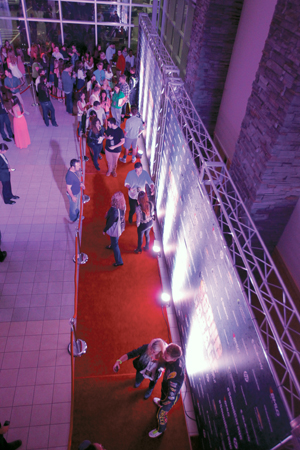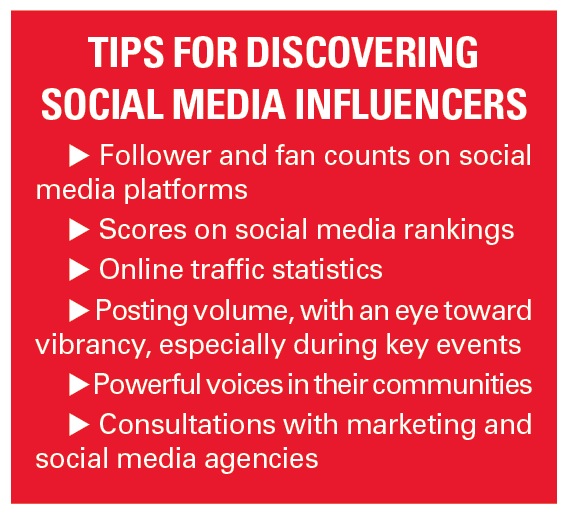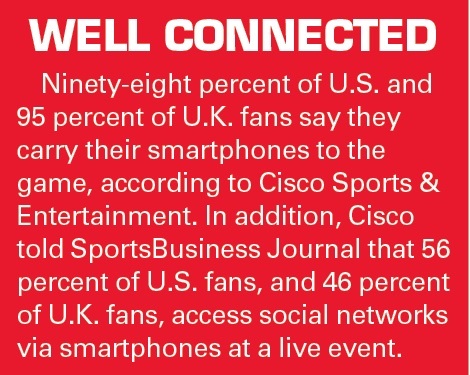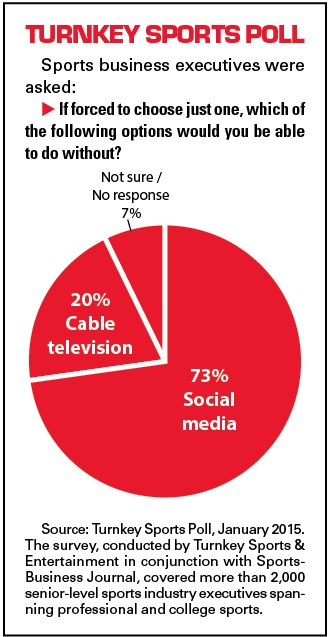The crowd inside the newly created “Ganassi Sound Garage” was unlike any ordinary auto racing event.
Filled with young people ages 15-24, the attendees last September were present at the North Carolina headquarters of Chip Ganassi Racing for a “DigiBash” featuring a red carpet walk, a concert by “The Voice” Season 1 winner Cassadee Pope, and appearances by Ganassi Racing’s trio of young drivers: Kyle Larson, Dylan Kwasniewski and Sage Karam.
Sports properties creating musical events as a tool for fan engagement is nothing new. But this particular event was an invitation-only affair involving more than 200 social media influencers in the Charlotte area. Selected in part with the aid of Dallas-based social media agency MVPindex for their activity and enthusiasm on platforms such as Facebook, Twitter and Instagram, the “DigiBash” attendees became part of the content of the evening, and in turn, brand advocates for Ganassi Racing’s team and NASCAR and open-wheel racing in general.
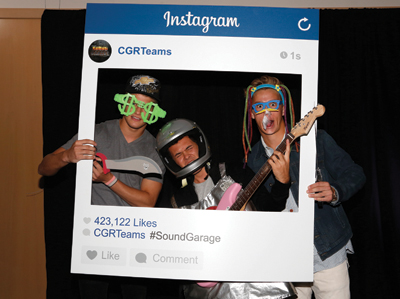 |
Chip Ganassi Racing drivers Sage Karam (left), Kyle Larson and Dylan Kwasniewski have some fun at an Instagram-themed photo booth that was part of the "Ganassi Sound Garage" event, which also featured a red carpet for arriving guests.
Photo by: Chip Ganassi Racing (2) |
The results surpassed even Ganassi Racing’s own hopeful internal projections. The team’s “DigiBash” generated more than 42 million social media impressions, roughly seven times the comparable reach among millennials in a typical race week, and was a top trending topic on Twitter in the Charlotte area for two days. More specifically, that volume of activity was largely a series of selfies and other photos from the concert posted across the major social media platforms and among that largely difficult-to-reach young adult demographic.
“Having the audience tell the story, letting the content be driven by them, was really the whole strategy behind the ‘DigiBash,’” said Steve Lauletta, president of Chip Ganassi Racing. “Honestly, when this idea was first developed, [Ganassi Racing owner] Chip [Ganassi] came to us and asked, ‘What is this concert? Why are we doing this?’ And when it was over, his first question was, ‘When are we doing the next one?’”
“But the reality is we have to take some risks and maybe be a little uncomfortable for a while if we want to develop new fans,” Lauletta said. “The younger fan doesn’t want to be talked to, they want to be actually part of the conversation. So for us, that mandates a different approach in how we engage them.”
Ganassi Racing’s experience with the “DigiBash” is just one of a fast-growing interest within the sports industry to engage social media influencers and have them become key pieces of marketing and content development strategies. Whether it be fully produced, large-scale live events such as this or more modest online marketing efforts, the core concept is the same: There is great reward in enlisting individual fans through social media to help evangelize one’s message.
“The advantages are clear using key influencers,” said Pat Donahue, manager of social media for the Los Angeles Kings, long considered one of the key thought leaders in the space.
The Kings routinely take advantage of their adjacency to Hollywood to engage celebrities such as actors Rainn Wilson and Eric Stonestreet, as well as influential local bloggers such as The Royal Half, in their social media efforts.
“Working with groups such as this allows you to reach a very different audience than what would typically come through the official team and league channels,” Donahue said. “You can really push the boundaries further and expand your message.”
The sports industry’s use of social media influencers borrows in part from retail and luxury brands such as Mercedes-Benz, Dom Pérignon and Burberry that have effectively leveraged platforms such as Instagram and postings there from active influencers for marketing gain. But for many properties, teams and sports-related brands, selecting effective groups of influencers and making their content appear sufficiently organic and natural is not an easy process.
“You have to have a valid reason to be part of the messaging,” said Bryan Rasch, chief digital officer for GMR Marketing, which has worked with a variety of brands including Hershey’s on social influencer-related programs.
“This area is still a huge challenge for so many brands, wherever they are in the space. They see a conversation happening, but so often, they simply force themselves upon it. But done effectively, there’s a real opportunity to create real partnerships with influencers and amplify their content in powerful ways.”
Non-traditional audiences
The Boston Red Sox had a similar goal of expanding its reach three years ago when the team began engaging with local mom bloggers, including Jodi Grundig, author of several popular destinations such as Mom’s Favorite Stuff and Family Travel Magazine; and Audrey McClelland, creator of MomGenerations.com, and a frequent member of various online power mom lists.
Over the past three seasons, the Red Sox have created a Moms Club composed of popular New England parent bloggers who are invited to several special events at Fenway Park, as well as participate in specially created gatherings such as a “FenwaYoga” session held last June at the ballpark.
The tradeoff is fairly simple, and for the team requires only a minimal budget outlay: The bloggers get a level of access at the ballpark typically not afforded to the general public such as VIP tours and special meet-and-greets, and in return, the team gets exposure in areas almost impossible to reach for a typical sports franchise.
The results have included a long series of social media posts and blog entries around the Red Sox and the Fenway Park experience, with minimal to no mention of the team’s 2014 performance that included its second last-place finish in three years.
The Moms Club effort also ties into a broader effort by the Red Sox to engage more youth and families in the
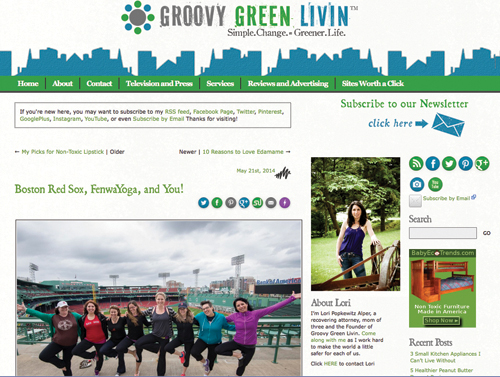 |
| The Boston Red Sox partnered with New England parent bloggers as part of efforts to engage more youth and families. |
Fenway Park experience, something that was harder to do when the team was setting a Major League Baseball-record, 794-game sellout streak that ran from 2003 to 2013.
“We knew we had to develop more non-core channels as part of our marketing mix, and engaging with this group of moms has been a really important part of that,” said Adam Grossman, Red Sox senior vice president of marketing and brand development. “What we’ve done is create a new group of brand advocates with a really powerful voice in our community.”
With its recent All-Star Game in Columbus, the NHL went after the same, hard-to-reach millennial audience that Ganassi Racing did, and employed the host team Columbus Blue Jackets for help. The league and Blue Jackets selected a group of what it deemed to be some of its most passionate fans to be part of the NHL’s social media team for the weekend, and highlighted their content across NHL.com and its social media platforms.
The league employed a similar strategy last spring for its #MyPlayoffsStory initiative in which fans were invited to post their own hockey postseason memories and perspective. It is planning an updated version of that initiative for the end of this season.
“It’s sort of like a distributed platform of people doing what they already do naturally,” said David Weiner, NHL director of social media marketing. “We think we have the most passionate fans in sports, and this is a really powerful way to showcase that.”
Selecting the pool
While the concept of working with social media influencers is easy enough to grasp, the details are often harder to execute. How should a team select the group? How does one engage them and secure permissions? How often should a team look to have the influencers create new content?
Not surprisingly, many teams and properties describe such processes as a mix of art and science. Follower and fan counts on platforms such as Twitter and Facebook, scores on social media rankings such as Klout, and online traffic statistics are frequently considered. So, too, is the level and vibrancy of posting volume, particularly during game times and other peak events on the schedule. Third-party social media and marketing agencies, such as what MVPindex did with Ganassi Racing, are sometimes consulted.
But what most clubs are looking for primarily in their influencers are personalities with prominent and powerful voices in their respective communities. And that’s more of a gut-feel call than anything else.
“We had three big buckets we were looking to make sure we had secured,” Grossman said of the Red Sox’s development of the Moms Club. “We, of course, wanted to make sure each of them had decent followings, and we put some research effort into that. We looked to make sure they shared the values of the Red Sox, and that was more of a qualitative exercise. And we wanted a diversity of opinions and backgrounds.”
MVPindex, which advises numerous brand and property clients, said teams can fall into numerous pitfalls in selecting social media influencers.
Among those traps: looking strictly at the size of follower counts instead of a more qualitative review of fan accounts, failing to find influencers who have a consistent, steady voice in the social conversation, too eagerly going for the “sell” in social media posts from influencers, and forgetting to look at international and other geographic or cultural trends.
“You have to remember to think about this globally,” said Kyle Nelson, MVPindex co-founder and chief marketing
officer. “We see very different trends, for example, in the popularity of something like Instagram here in the U.S. versus elsewhere.”
Donahue, in his work with local celebrities, often seeks to cut out middlemen such as agents and lawyers. He frequently converses with celebrities over platforms such as Twitter direct messages, allowing for quick, direct conversations with those actors and musicians. But in looking to develop activities such as Twitter takeovers by those personalities, it’s a delicate balance to make sure the efforts don’t come across as overly forced.
“These guys are tremendous fans and they can do so much for the development of your brand,” Donahue said. “But it’s so easy to tell when something feels fake. So it’s a really fine line you have to walk.”
Executives with the NBA agreed. With more than 750 million likes and followers in global social media reach, the league has placed a high priority on authenticity.
“You simply can’t mandate to anybody to post something,” said Melissa Rosenthal Brenner, NBA senior vice president of digital media. “So a lot of what we do is simply listen to the conversation out there and surface the best content. It has to happen organically. It’s what I would call aggressive listening. But there’s no doubt our fans, whether they be celebrities or not, are our best advocates.”



